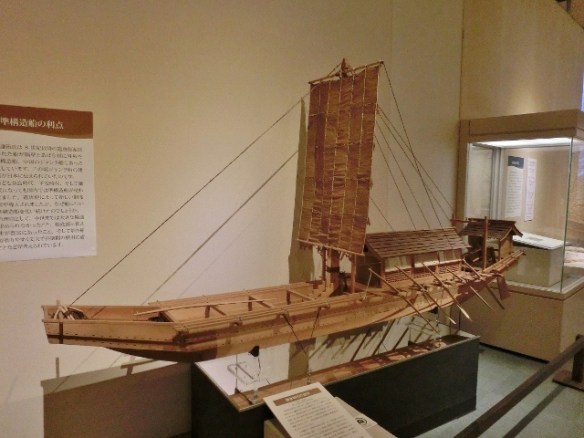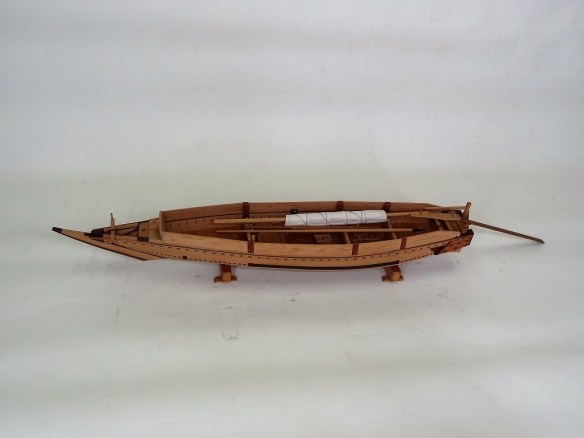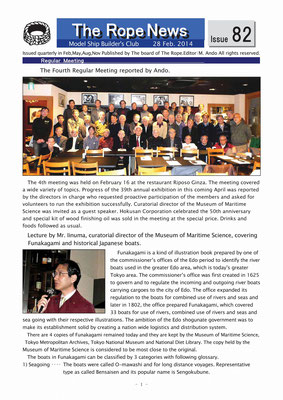It’s been developing slowly over the years, but The Rope Tokyo, has been updating their website with an increasing amount of material on traditional Japanese ships and boats and their models. Over the years, they’ve added some material from presentations given at their regular meetings. But, more recently, they’ve added a section showing types of ships and boats, based on model built by members, as well as a section showing models of boats preserved at the Ota ward local museum (a collection that I was actually involved in discovering).
Tag Archives: The Rope
Wasen Mokei Website in The Rope Newsletter
My wasen modeler / wasen mokei website got a nice little blurb in the most recent issue of The Rope Newsletter. This issue, due to the coronavirus, is an expanded issue based on member reports, and not just based on members attending a meeting, as they usually are, so it’s a big issue, 36 pages!

In a half-page section of their Overseas Report, my Himi Tenma model got some mention. But, probably more importantly, the website got some attention. The writeup even goes so far as to suggest that “It may be a great help even for Japanese modelers…”. So, it’s nice to see that there is enough content here to gain a little recognition. Hopefully, I’ll be able to keep building up the content for some time to come. Below, is a link to the full newsletter, so you can see what’s going on with some of the ship modelers in Japan:
https://drive.google.com/file/d/1i7WJHFhxjbRJQF3UCweo2dfGQgDWTT3N/view
Ω
Building the Kamakura Period Umi-Bune – Part 8
I must confess that I haven’t done much on the umibune model itself. I’ve mostly been working out details on how to make or modify figures for it. I’ve been using wire frames, modifying plastic figures, etc., trying to develop some skills that will work for me. More on this later.
I’ve also been testing out a way to make the large square sail for it. It’s a little different from other sails because sails weren’t made from cloth at that time in Japan. Instead, they were made from straw mat. They were heavy and bulky and you certainly didn’t want to get them wet. I’ve been looking at how these have been modeled on museum models and one large scale 1/10-scale model that someone sent me photos of.
Building the Kamakura Period Umi-Bune, Part 7
One of the detail features of this vessel is that the railings are fastened to the beams by rope ties. There may have been more to it than that on the real boat. I have seen where a wooden key is used to keep two parts in alignment, while a rope binding holds them together. That may be the case here. But, all that really matters is what can be seen, so it’s important that the bindings make sense and they are all the same.
The Rope: Article on the Funakagami and Historical Japanese Boats
Continuing with a string of posts about the Japanese ship model society, The Rope, here’s a short, but very interesting article describing a talk given by the curatorial director of the Tokyo Museum of Maritime Science. In this talk, Mr. Iinuma describes Japanese historical boats and the role of the book, Funakagami. I posted about this earlier in the year, along with a link to a downloadable pdf copy of the book. This article in The Rope News is a better discussion of the book that mine, and it’s a very short summary.
I read this and, learned a few key things that I didn’t know about. One in particular was why the stem (the term bowsprit is mistakenly used here) on many yakatabune shown in wood block prints, look incomplete. I’ll let you read that answer for yourself. You can read the article online or download a copy:
https://drive.google.com/file/d/0B6tkJLrPbZUEa21zZ0JmMmMxYTQ/view
And, here is a link to my own blog post on the Funakagami where you can download a copy directly from the Tokyo Museum of Maritime Science: https://wasenmodeler.wordpress.com/2016/08/18/funakagami-a-pdf-book-on-japanese-boat-types-2/
The Rope: Photo Gallery of Japanese Sailing Ships and Boats
I only just discovered that there is a page on the website of the Japanese ship model society The Rope that features models of Japanese ships. These include some modern era ships, but several Edo period ships are represented. This group does some really beautiful work, which I recommend checking out.
Here’s a link to the page, which is on the English language section of their website: https://theropetokyo-en.jimdo.com/japanese-ships-1/photo-gallery-of-japanese-ships/
Building the Kamakura Period Umi-Bune, Part 6
As I mentioned in my last post on this model, I’d been wrestling with the configuration of the roofs. The 1/20-scale museum model that I often see reference on the web, differs from Professor Ishii’s 3-view illustration that I’ve mostly been basing construction on. Those drawings are more of a match to the early scroll paintings. Oddly enough, none of the models I’ve seen match them exactly. Is it possible that the builders had access to more updated information? Or did they just decide that the Ishii-san was wrong? But, then what about the scroll paintings? Are they simply written off as being wrong?
As you can see in the photo below, which was taken at a ship model club meeting, I initially made flat roofs panels. If I could justify them, they would certainly be the simplest to construct.
Wasen Models of the Ōta Ward Museum (大田区の博物館)

五大力船 – Godairiki-sen. 1/10 scale. One of the models in storage at the Ota Ward Regional Museum. Photo courtesy of Ota Ward Folk Museum, and taken by The Rope Tokyo.
The Ota ward’s regional museum is a place I’d never heard of, and nobody told me about. I discovered it one day as I was digging through an old database file I stumbled across on the Nippon Foundation Library website. Not being able to read much Japanese, I downloaded an Excel spreadsheet and began translating piece of it to figure out what I had. What I found was a list of about 900 wasen models and their dispositions. Included in the list was their city location and address.
I recognized the kanji for Tokyo, 東京, so I focussed on those. I copied and pasted the address into Google Translate, and I got that the address was in the Ōta ward. Now, I’ve been to Tokyo a few times, but I’m not too familiar with the system of wards, which are subdivisions of cities. But, I had the address and popped it into Google Maps, which allowed me to locate it precisely, and even do a virtual walk around the area.
Building the Kamakura Period Umi-Bune, Part 5

Model on exhibit at Kanagawa University. Photo by Masami Sekiguchi.
No, that’s not my model. This 1/10-scale model of a Kamakura period umi-bune is on display at the Kanagwa University, which is home to the Institute for the Study of Japanese Folk Culture. The photo was taken by my friend Masami Sekiguchi, who is one of two Japanese ship modelers I met with in Tokyo last September. The other is Norio Uriu, Both gentlemen are members of The Rope, the Japanese ship model society in Tokyo.
I had been corresponding with Mr. Uriu for over a year, as he is a friend of fellow ship modeler Don Dressel of the Ship Modelers Association in Fullerton, California. Don was building his model of a Higaki Kaisen at about the same time I was building mine, and at some point, he put me in touch with his friend in Japan, Mr. Uriu.
When I travelled to Japan, I made arrangements to meet with Mr. Uriu for dinner in Tokyo and he brought along his daughter Hanako, who helped with our discussions, and Mr. Sekiguchi, who has been helping me understand information on Japanese ever since.








